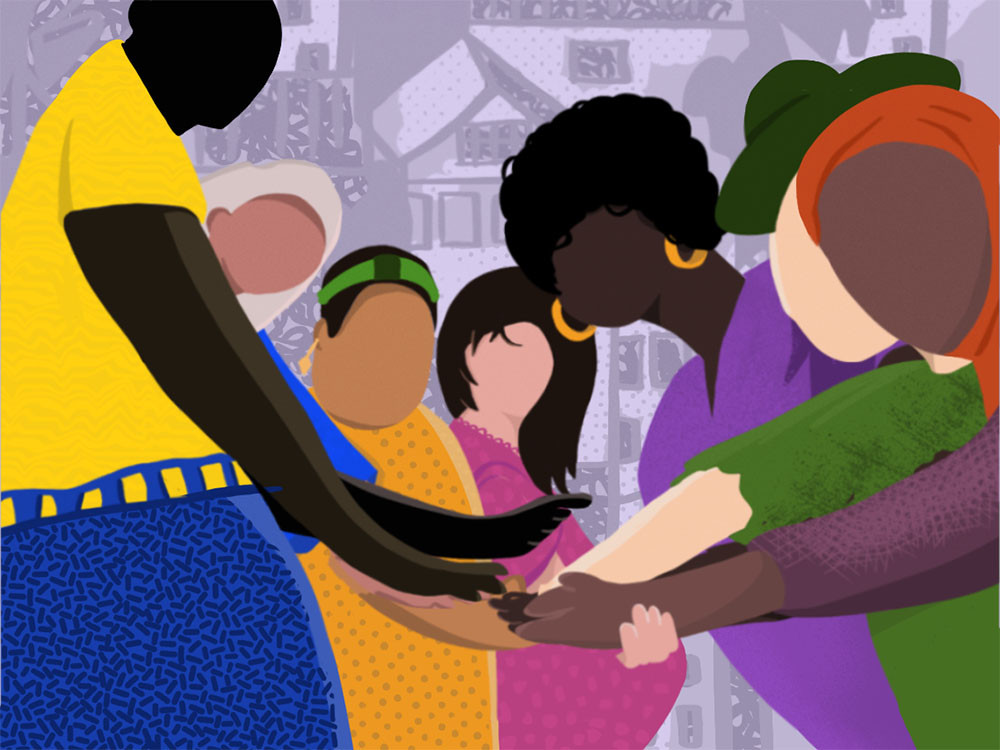 (Illustration by Raffi Marhaba, The Dream Creative)
(Illustration by Raffi Marhaba, The Dream Creative)
The long and continued practice of racist housing practices and policies in the United States means that Black people, Indigenous people, and people of color are the most likely to have insecure access to safe and affordable housing, to be unhoused—and to live in places that are disproportionately vulnerable to the effects of climate change. The racial reckoning of 2020 opened many funders’ eyes to the fact that we cannot achieve housing justice without also addressing racial justice, and vice versa. As the number of climate-related disasters grows, a second truth commands attention: To solve the housing crisis, we must simultaneously solve the climate crisis, and do both in ways that prioritize those who have had the least to do with creating either.
Not only do these climate disasters wreak their own havoc, they strain the crumbling infrastructure of long-disinvested places like Jackson, Mississippi, where storms in August 2022 left 150,000 residents without running water. The forecast of our future includes more of these disasters, plus longer pollen seasons, loss of biodiversity, chemical pollution, rising sea levels, heatwaves, cyclones, and devastatingly strong winds. An estimated 35 million American homes, almost a third of the country’s housing stock, currently face high risk of a weather-related disaster while millions more are trapped in housing without efficient heating and cooling systems or mechanical ventilation to improve indoor air quality.

Moreover, as higher-income households leave vulnerable coastal areas and move to higher elevations, climate gentrification is beginning to occur: Middle- and upper-income people move into lower-income areas, whose longtime inhabitants often were driven there by discriminatory housing practices and policies. Property values shoot up, as does the cost of living, and lower-income households are displaced. If we don’t expand the way we think about housing to include the impacts of climate change, our well-intentioned efforts to create, provide, and preserve housing will still leave vulnerable populations in untenable situations.
Funders for Housing and Opportunity (FHO) is a collaborative of 13 philanthropies, including The JPB Foundation where I serve as senior vice president of environment and strategic initiatives. In Gray to Green Communities: A Call to Action on the Housing and Climate Crises, I wrote about shifting housing from gray practices that produce short-term benefits for a few people, but have negative long-term impacts on the majority of people and the planet, to green practices that benefit everyone and support healthy people and places. FHO, which centers racial equity in cross-sector efforts to address the systemic causes of housing insecurity, is now actively searching out ways to invest in housing and climate justice. In this article, I talk about collective actions that funders can take to holistically address climate-related impacts on housing justice.
Moving Toward Holistic Solutions
Two priorities in climate and housing justice are mitigation and adaptation. Mitigation aims to prevent further harm by avoiding and reducing emissions of greenhouse gases in the ways that we build and preserve housing. Currently, an estimated 20 percent of emissions in the United States comes from the energy used in homes. Mitigation practices include green building (i.e., using non-toxic building materials that were manufactured, transported, and constructed using low-carbon, non-polluting methods and materials); reducing energy consumption and pollution; and using integrative design, which incorporates sustainability up front and promotes good health and livability throughout the building’s life cycle.
Adaptation is about how we adjust to the climate and its effects; it aims to avoid or minimize harm. Adaptive practices in housing include changing building codes to make homes more weather resistant, using resilient design to ensure homes can be safely and comfortably used when conditions change outside (e.g., by storing solar energy), and thinking about what happens to housing after major climate events.
We desperately need both mitigation and adaptation—and that means we cannot simply focus on exciting new products and technologies. We also have to remediate the harm that has already been done. We must listen to and work with communities that already have taken control of their futures through solutions that build local wealth and stop the cycle of extraction and pollution. For example:
- Community organizers in San Juan, Puerto Rico, persuaded legislators to establish a community land trust to prevent resort developers from grabbing land from low-income residents who must evacuate so the government can dredge a polluted waterway that floods when it rains.
- The United States has approximately 250 land banks—public or nonprofit entities that acquire, manage, and transfer buildings and lots that are vacant, abandoned, or foreclosed, often because of economic or natural disasters—and they sometimes redevelop these properties to provide affordable housing and stabilize property values. In Michigan, fast-track legislation gave county land banks leeway to creatively reinvest in and rebuild these properties; the Michigan State Land Bank Authority, which owns more than 4,500 such properties, many of which are contaminated, is exploring options for solar power development on some of them.
Strategies like these can prevent or reduce displacement in areas that are vulnerable to climate-related gentrification, and they demand our attention and investments.
As we work to make future buildings healthier and safer for people and the planet, we also have to respond to the fact that half a million children, the majority of whom are in predominantly Black and/or high-poverty neighborhoods, already live in housing that exposes them to lead. As we lament that the percent of income spent on energy costs is three times higher in low-income households than in middle- or upper-income ones, we should also be concerned that the poor construction and condition of aging housing contribute to that disparity.
Mitigation, adaptation, and remediation are interconnected. But the solutions coming from the fields of housing and climate change often are not as holistic as they need to be. If we only think about housing in terms of the end product—simply sheltering people or putting solar panels on a roof, for instance, or lifting a building’s foundation to preempt flooding—then we’re missing the big picture. Housing is part of a broader ecosystem in which truly green building not only mitigates climate change but also boosts health, employment, and the economy not only for the communities where the housing is located but in all communities including those from where the electrical power is generated and the building materials are manufactured. If we shift to thinking about the problems and solutions holistically, we open up many more options to advance racial, housing, and climate justice in one fell swoop.
Fortunately, we see many opportunities ahead to do exactly that. More than 27 housing finance agencies have now adopted the Enterprise Green Communities Criteria as a requirement for designing, building, and rehabilitating homes that are affordable and healthy, lower residents’ utility costs, enhance residents’ connection to nature, protect the environment, and advance the health of local and regional ecosystems.
In February 2021, the United States rejoined the Paris Climate Agreement, creating new momentum to support climate change solutions including those that put housing front and center. President Biden also committed to the Justice40 Initiative, which aims to direct 40 percent of the benefits of certain federal investments—including those in climate change, clean energy and energy efficiency, and affordable and sustainable housing—to disadvantaged communities that are marginalized, underserved, and overburdened by pollution. And in January 2022, the US Department of Housing and Urban Development (HUD) opened access to more than $2 billion in federal funds to help communities equitably recover and improve long-term resilience to disasters and future climate impacts. These developments all point to a political and funding context conducive to climate and housing justice.
What Philanthropy Can Do
Private and public funders can commit to ensuring that everyone has access to a house they can afford, regardless of race or income, on a planet that is thriving—and support that goal with adequate funding, incentives, and regulations.
For example, philanthropy can help guide federal funding by expanding initiatives like the Justice40 Accelerator, which was launched in 2021 by a coalition of environmental and climate nonprofits, funders and other mission-aligned organizations including Elevate, Groundswell, Hummingbird Firm, Partnership for Southern Equity, and The Solutions Project after President Biden created the Justice40 Initiative. The Accelerator, with implementation partner People’s Climate Innovation Center, provides technical assistance, peer learning, and other support to help climate and environmental justice organizations build capacity, partnerships, and readiness to access federal funds. Participating organizations must be grounded in, benefiting, and accountable to communities on the front lines of environmental and climate crises, which often are Black and historically disinvested communities of color.
Philanthropy also can stop making investments that support fossil fuel infrastructure and allow additional emissions of greenhouse gasses, and instead do everything we can to protect and prepare people and communities for the effects of climate change. We see examples of what is possible in communities like Buffalo, New York, through the efforts of PUSH (People United for Sustainable Housing) Buffalo, a nonprofit that uses community organizing, policy advocacy, and neighborhood redevelopment to create green affordable housing and resilient neighborhoods. PUSH not only runs organizing campaigns to propose policy changes, such as establishing a Buffalo Tenant Bill of Rights, it also has purchased vacant lots and buildings and redeveloped them into green spaces with green, energy-efficient housing, produced in ways that created living-wage jobs for neighborhood residents.
FHO has already committed to centering racial justice in housing justice. Now, I hope we can also center climate action in our work to meet the housing challenge. A 2022 report from Harvard’s Joint Center for Housing Studies declared, “Housing is now squarely established within climate policy as part of the strategic toolkit for reducing greenhouse gas emissions and as a channel for addressing the exacerbated social and economic injustice that fossil fuel consumption has wrought.” It’s time now for climate mitigation and adaptation to be squarely embedded in housing justice efforts. We cannot afford to do one without the other.
Support SSIR’s coverage of cross-sector solutions to global challenges.
Help us further the reach of innovative ideas. Donate today.
Read more stories by Dana Bourland.

